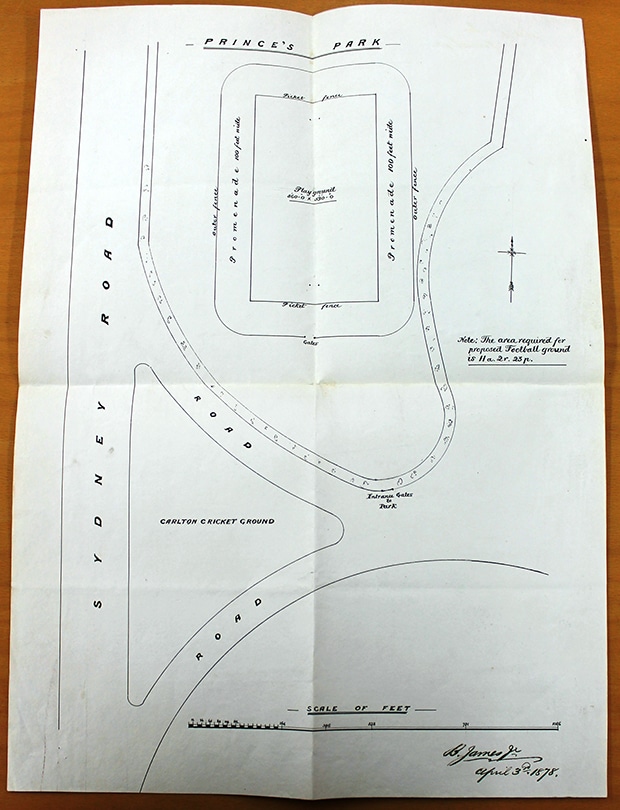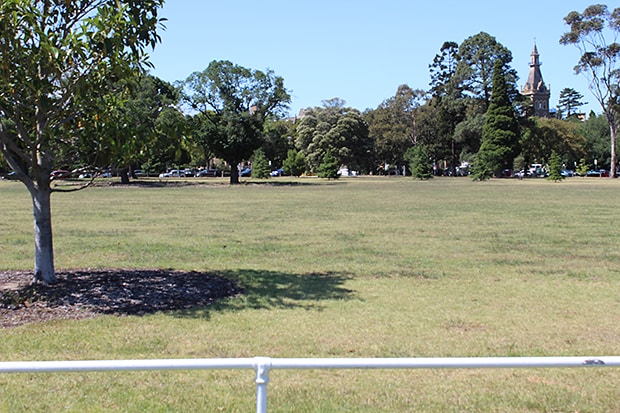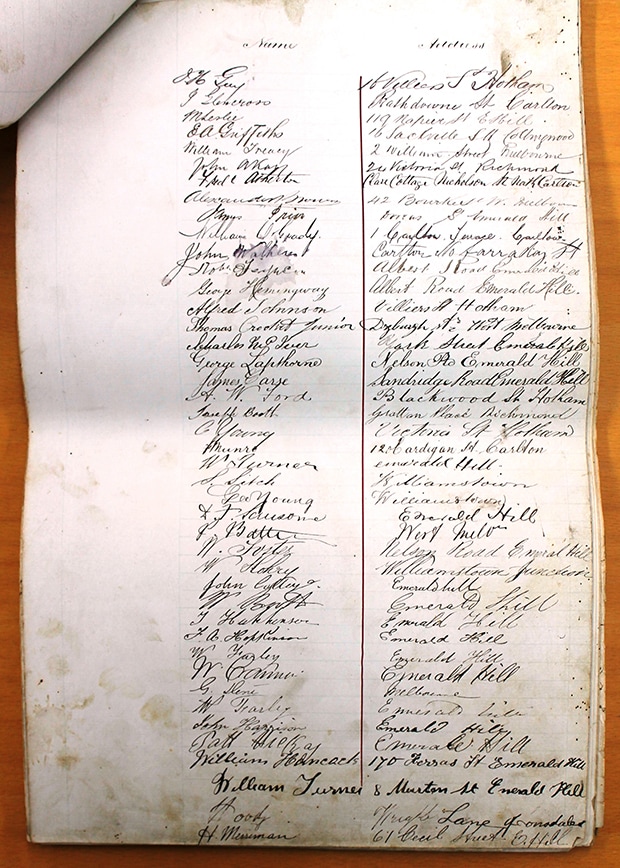A petition signed by more than 3500 local ratepayers in support of Carlton’s ultimately successful push to stage matches on the southern portion of Princes Park in 1878, has been located in the Public Records Office in neighbouring North Melbourne.
An original draft of the dimensions of the proposed playing field – a rugby-like strip just south of Carlton’s existing training headquarters near Crawford Oval on Princes Park Drive - was also found with the petition and other historic club papers.
Marked “1878”, the Carlton petition to the Melbourne City Council was unearthed by emeritus scholar in history at La Trobe University Dr John Hirst, who promptly notified the football club’s CEO Steven Trigg of this significant find.
As Dr Hirst noted in his letter: “The result finally was that [Carlton] was allowed to play in the southern portion of the Park, but any fences erected could only be temporary. It was only in 1896 that the club acquired the land in the north of the park which it could fence and develop”.
This story has its origins prior to the commencement of the 1878 season when inaugural VFA Premier Carlton, as tenant of the Madeline Street (now Swanston Street) Reserve on the site of what is now Newman College, was ordered by Melbourne University to immediately vacate the ground to enable building works to proceed.
For reasons wholly unexplained, Carlton was evicted from the Roman Catholic Collegiate Reserve in Madeline Street, despite considerable moneys and time spent in converting the area from what a knowledgeable writer to The Age in early May 1878 noted was “a rugged and barren waste into an attractive lawn”.
“I would point out that a great injustice has been done to the club; and seeing by its exertions one great charity (the Melbourne Hospital) has benefited considerably, I think that a full explanation is due to the public as well as to the club . . . ,” the author wrote.
For a brief period, football gave way to hurling on Madeline Street until Hotham Football Club (later North Melbourne) took occupancy of the ground - which riled the Carltonites no end.

An original draft of the dimensions of the proposed playing field. (Photo: Carlton Football Club)
“Fair Play”, in a letter to The Argus on May 31, 1878, objected to Carlton’s removal from Madeline Street, noting that the hurling club was now charging admission, which was one of the reasons the university evicted Carlton.
“Sir, - Having read in your columns some time ago that the council of the University had refused the request of the Carlton Football Club for permission to play on the Madeline-street reserve either for pecuniary benefit or otherwise, I was very much surprised on Saturday last to find that the hurling clubs were playing a match on the same ground, and were charging for admission,” Fair Play wrote.
“I think that this is very unfair to the Carlton Football Club, who have made nearly all the improvements there.”
Another letterwriter later contended that despite the university’s view that football could not be played “within the sacred precincts of the University, the Hotham club was given the best surfaced ground in the city which was financed by the Carlton Football Club and its supporters”.
Associate Professor Lionel Frost, author of the acclaimed Carlton Football Club tome “The Old Dark Navy Blues”, acknowledged the divide between Carlton and Hotham through this period. As he noted: “Throughout the 1870s and 1880s Carlton had a less than friendly relationship with Hotham Football Club (re-named North Melbourne in 1888), due to a string of on-field incidents”.
How ironic, given Hotham’s encroachment on Carlton’s turf, that the petition should be located in a vault in North Melbourne after all these years.
In the event of its eviction from Madeline Street, Carlton for a brief period fielded teams on the grounds of Royal Park, not far from where Burke and Wills’ expedition set out on 3250-kilometre trek by camel to the Gulf of Carpentaria in August 1860. There, in matches involving Excelsior, Hotham United, Fawkner/South Yarra Standard and South Melbourne, the likes of the great George Coulthard and John “Tiger” Gardiner chased the leather.

The site of what is believed to be the old Carlton ground in the southern portion of Princes Park from 1879-1886. In the distance is the site of the Madeline Street Reserve (now Newman College), the ground from which Carlton was evicted. (Photo: Carlton Football Club)
“For most of the nineteenth century, Carlton did not have use of an enclosed ground of its own,” Associate Professor Frost noted. “Early games were played on open parkland, but the club played home games at 10 different grounds (including the MCG, plus one at Victoria Park) before 1897.
In the meantime, the petition carrying the signatures of ratepayers of the various Wards of Melbourne (most of them Australian rules devotees) was taken out.
The petition’s cover letter was signed in pen and ink by James Munro, the then secretary of the Victorian Permanent Property Investment & Building Society (and later the 15th Premier of Victoria).
Signatories to the petition pushed for Carlton’s occupancy of 11½ acres in the southern portion of Princes Park for the fielding of a rectangular playing strip measuring a massive 860 x 590 feet or 262 x 180 metres (the MCG’s dimensions are 171 x 146 metres) and surrounded by a picket fence and promenade.

Pictured are some of the 3500 signatures for the Princes Park petition. (Photo: Carlton Football Club)
The cover letter reads as follows;
Munro J & Others
Date Received 3/6/’78, No. 768
Petition asking for a portion of Princes Park for a Football Ground
To The Right Worshipful the Mayor, Aldermen and Councillors of the City of Melbourne.
Worshipful Sir and Gentlemen,
We the undersigned ratepayers and other residents in the various Wards and Suburbs of the City of Melbourne being admirers of the popular and manly sport of Football and concurring in the action of the Carlton Football Club in applying for the southern portion of the Princes Park as a playground desire respectfully to give such application our heartiest support.
The improvements made by that Club in the Roman Catholic Collegiate Reserve Madeline Street (which, through intended building purposes the members and thousands of the public are now necessarily excluded from) have strongly impressed us with the urgent desirability of its obtaining a ground suitable for the players and advantageous to the public; with a full knowledge of the unselfishness of the object and the great boon to be devised from its use, we hasten to entreat the Corporation to grant the Club’s request, that the coming winter may see us in the full enjoyment of what we have hitherto so gladly participated in.
While large areas are available and conserved for the summer recreations (that is to say) Cricket and Bowls, the acknowledged and most important feature is compelled to resort to a makeshift under disparaging surroundings.
We unhesitatingly affirm that at no time of the year is our Saturday half holiday more keenly relished or better enjoyed than when that recreation is being pursued. We may be allowed with feelings of pleasure and pride to add an entire satisfaction at the outcome of the occasions when the sport has been made a voluntary medium of charity rendered the more gratifying by the spontaneous and favourable acknowledgements by the Press of the efforts of our youth, who while enjoying a rational, vigorous and healthful amusement, are farming that all-important essential “a sound national character”.
Concluding with our most earnest wish that the Corporation may see fit to graciously acceded to your Memorialist’s wishes.
We respectfully beg to subscribe ourselves;
James Munro, 46 Collins Street
(co-signatory illegible)
Alderman O’Grady objected to Carlton’s push for occupancy of Princes Park’s southern portion on the basis that the area was within too close a proximity to the Melbourne General Cemetery and might upset visitors and funeral services.
But Councillor Curtain moved an amendment “That the use of the park be granted to the Carlton Football Club for the winter season” and Alderman Gatehouse seconded the amendment.
The Bendigo Advertiser reported that “a very long discussion” was held in council chambers on the afternoon of Monday, June 10 “upon the subject of granting a portion of Prince’s Park on the Sydney Road, to the Carlton Football Club, for a playground”.
“The Health Committee had recommended that the application be not acceded to, on the ground that the land was very near to cemetery, funeral processions would be disturbed by the noise, and a motion had been moved that the reason given by the health committee was insufficient, and that the application be granted,” the report noted.
“The Council decided at last to let the Football Club have the ground on condition that they did not damage the trees in the park, put up fences, or make a charge for admission.”
On Saturday, June 15, 1878, The Australasian reported that “The City Council on Monday last granted the use of 11 acres of the southern portion of the Prince’s-park, which was the piece they applied for, to the Carlton club”.
The permissive occupancy came with stringent conditions - “that no fences were erected, no fees charged, that the club should be responsible for any trees destroyed, and that the council should have power at any time to revoke the present arrangement”.
In his reporting of the development, the journalist Peter Pindar offered his hearty endorsement of the successful Princes Park push.
“ . . . On the principle that ‘half a loaf is better than no bread’, I am heartily glad of it,” Pindar wrote.
“I presume no objection will be offered to the placing of movable hurdles round the playing space during the game, to keep the crowd back, as these will not come under the designation of ‘fences’; otherwise the permissive occupancy would be of small value.
“As no fees are to be charged, the offertory boxes can come into requisition again to reimburse the club any necessary outlay in improvements.”
On the afternoon of Saturday, May 3, 1879, Carlton met Carlton Juniors (an amalgam of the Victory, Lincoln and imperials clubs) in that historic maiden fixture on what became known as “The Oval”.
An unnamed reporter for the local Leader newspaper wrote;
“The new ground of the Carlton Club in Prince’s Park, situated just beyond the cricket ground, and close to the Brunswick-road (Sydney Road) should, from its appearance, prove unequalled as an arena for play. I have not got the measurements, but roughly I should say it must be close on 200 yards in length, by 150 wide. It is enclosed by the same fence that was used when the Carlton were allowed to play on the Madeline-street reserve, and it has been levelled and sown with English grasses. The amount of work done may be gathered from the fact that £148 has been expended in levelling, grassing and weeding, £25 in repairing the fence, and £74 in painting it, the total expenditure to date being £265, in which, as it will be seen, the cost of making the fence is not included.”
Carlton would field teams on that southern portion of Princes Park from 1879 to 1886, during which time its inability to complete any improvements forced it to stage matches at alternative venues including the East Melbourne Cricket Ground, the MCG and the Friendly Societies Ground (not far from Olympic Park) where it could charge spectators admission.
Today, on the site of the old Carlton football ground near Crawford Oval, a sign placed by the local council reads as follows;
Welcome to Princes Park
ORGANISED TEAM SPORTS ARE REQUIRED TO OBTAIN A PERMIT FOR THE USE OF SPORTSFIELDS IN THE CITY OF MELBOURNE


